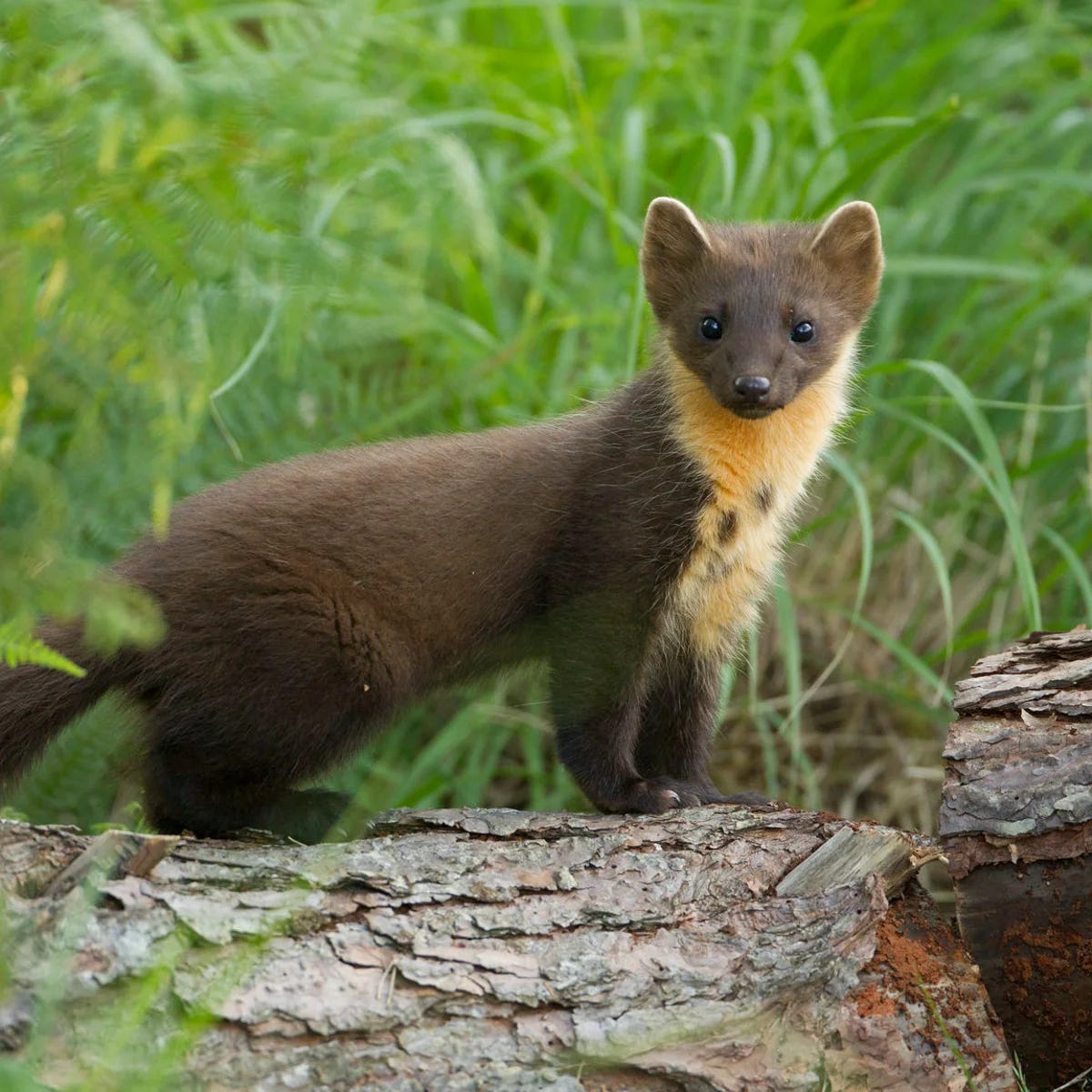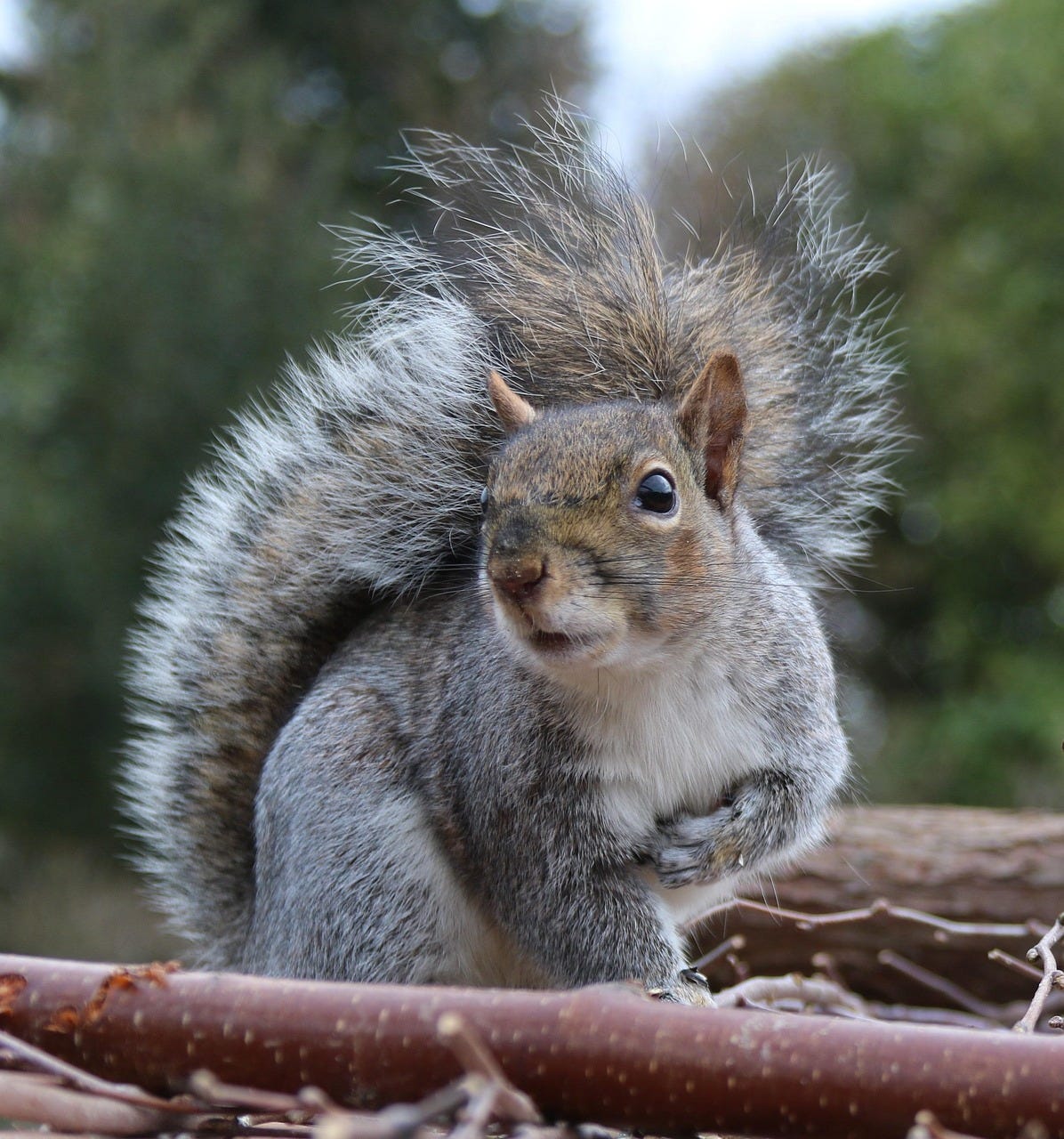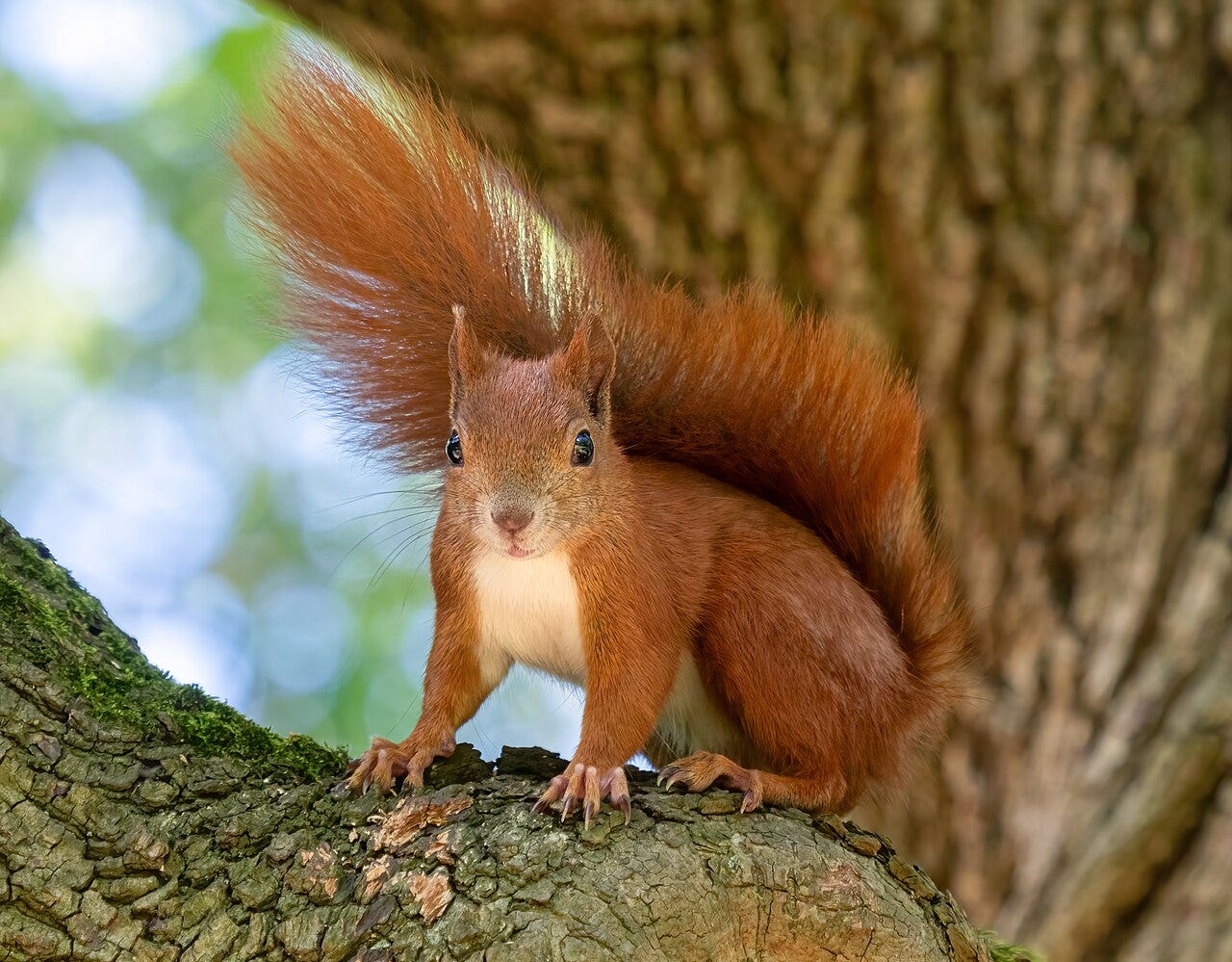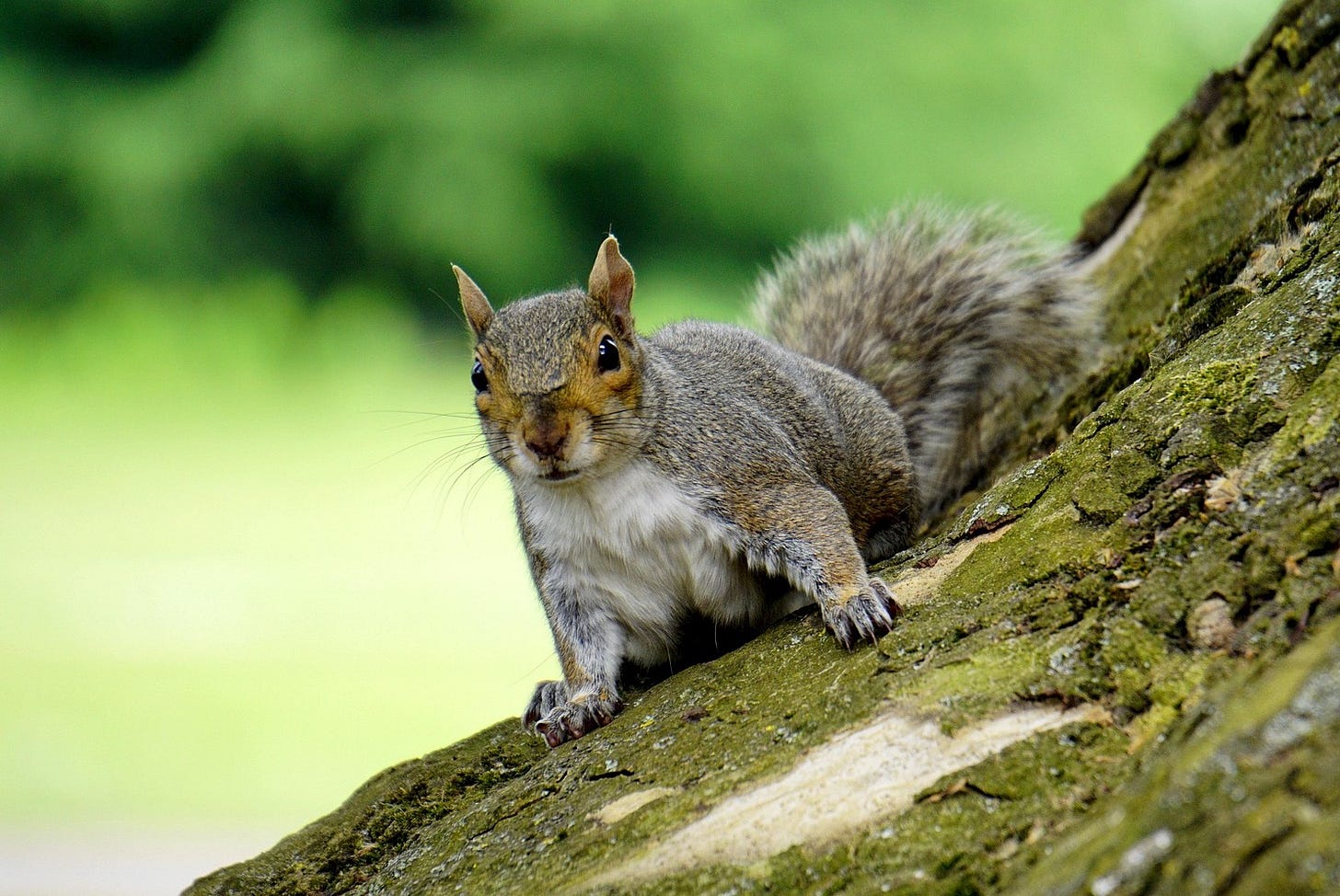The twisted tale of squirrels in the UK
Red squirrels, grey squirrels - they all look adorable, don’t they? But when it comes to Britain, it’s become a pretty one-sided story of good squirrel, bad squirrel.
The way the story in the UK goes is that the red squirrel belongs, the grey squirrel doesn’t. Red squirrel = good; grey squirrel = bad. Our species created the mess in the first place, of course, by bringing the grey squirrel to England. And then over time red squirrel populations dramatically decreased, and, in mitigation efforts, grey squirrel populations have been killed in the many millions.
How did we get here?
The 11th Duke of Bedford carries a major share of the responsibility. Between 1876 and 1929, grey squirrels were brought from North America and released at about thirty different sites. Before then, there were only red squirrels in Britain and all the well-meaning humans didn’t consider the possibility that red squirrels and grey squirrels wouldn’t get along.
Before we go deeper into grey squirrel territory, let me just spend a moment on red squirrels - it’s not like our species allowed them to fare well before the arrival of the grey squirrel. I’ve read that deforestation for agriculture, fuel and war caused the regional extinction of the red squirrel in Ireland and southern Scotland in the 18th century. Reintroductions with reds from England and from Scandinavia followed.
At the time grey squirrels were brought to Britain, reds were thriving again, and were considered a nuisance of plague-like proportions. They were “slaughtered in their hundreds of thousands as woodland pests who strip bark, rob birds’ nests and raid gardens.” And so, from 1900-1925, they were heavily persecuted and killed by humans … no doubt this unintentionally aided the rise of the grey squirrel. More on this here.
Back to the grey squirrel: A 2016 study by the Imperial College London looked into the fast expansion of grey squirrels. Based on DNA results they concluded that grey squirrels did not rapidly spread on their own, but that human assistance was the main contributing factor - and that human assistance came courtesy of the aforementioned Duke of Bedford, Herbrand Arthur Russell, President of the Zoological Society of London from 1899 to 1936.
Researchers of the mentioned study call him “one of the worst offenders” as he released and gifted grey squirrels around the UK. It is quite a distinction when, on your Wikipedia page, the opening paragraph remembers you primarily for being the “chief importer of the invasive grey squirrel species to Britain.”
But let’s not leave the man with that stain. He helped save from extinction the Père David’s deer and the Himalayan tahr and, after all, the grey squirrel’s powers of invasion were not understood at that time. When, in 1909, grey squirrels were released in London’s Regent’s Park by the Zoological Society of London, it was thought to be a great success. It wasn’t until a dozen years later that The Times reported:
“A dozen years ago the Zoological Society of London obtained a number from a private collection in Bedfordshire for the purpose of inducing them to breed at liberty in the Gardens in Regent’s Park. They were first kept in a large enclosure from which, when they had become used to visitors, they were allowed to pass in and out by a rope bridge to a tree. It was hoped that they would spread from the Gardens to the Park.
After two or three years in which they seemed to be disappearing, they suddenly became ubiquitous...The grey squirrels are plainly happy and plainly give happiness to Londoners...On the other hand, grey squirrels, whether by taking advantage of tubes and buses, or by deliberate human connivance, have spread from London and are invading the country over very wide areas. They are said to drive out the red squirrel, to raid gardens, and to add to the anxieties of the pheasant breeder. We hope that fuller inquiry will not sustain these charges.”
Well, eventually they knew better - but by then it was too late.
The ‘crazy invaders’ today
Today there are over 2.5 million grey squirrels in the UK, with most of them making England their home. As for the smaller red squirrel? Well, they were pushed out of the way and today there are less than 300’000 red squirrels in Britain, with the majority in Scotland, far away from grey squirrels.
In the mentioned study by Imperial College’s Dr. Lisa Signorile, it is revealed that the various grey squirrel populations remain genetically distinct - meaning that they don’t travel great distances and don’t interbreed much. Signorile recounts:
“It has been thought since the 1930s that grey squirrels were all the same, spreading across the country as one invasion front. After a century, genetics has proved that this isn’t correct. They are not that good at breeding and mixing – in fact there are clear signs of inbreeding. Grey squirrels are not as crazy invaders as we think – their spread is far more our own fault.”
But even if Dr. Signorile has cleared them from the stigma of the super-invading force, the numbers today speak for themselves. They grey squirrel is bigger than the red, thus able to outcompete it for resources. It breeds faster, too … and then the grey squirrel also carries with it a deadly weapon - the squirrelpox, a disease that they seem to be mostly immune to, but that kills red squirrels.
Shoot them! Poison them!
After loving the grey critters for about fifty years, people in the UK realized the disastrous effect the greys had on the reds and so, for the past seventy years or so, a war or sorts has been waged against the grey squirrel.
Post WWII, people were encouraged to kill grey squirrels. They were given free cartridges and paid a shilling for each tail handed in. Over a million greys were killed in that way, but it’s safe to say that all of that killing didn’t work - see above map!
In the seventies, the Forestry Commission came up with a new idea: poison. They introduced Warfarin (what a name). Again, allow me to mention the above map. Poison clearly didn’t work, either. And one can only imagine just how many other animals died as collateral damage.
So what’s to be done if shooting and poisoning in the millions over the course of decades didn’t do the trick with a species that is perfectly adapted to the environment and that breeds rapidly (2 litters a year with around 7 little ones each time).
You know, maybe, just maybe, how about giving nature a chance?

Enter the pine marten
The pine marten is a carnivore (omnivore, actually) and carnivores do what carnivores are supposed to do - by hunting and killing they regulate their environment. So when you have a pine marten who loves the occasional squirrel meal, you can be sure that those squirrel populations will be impacted.
As it turns out, grey squirrels don’t know the pine marten (it’s not a North American native), whereas red squirrels do (it is ubiquitous across most of Europe). The pine marten will hunt both reds and greys - but because reds are used to that threat, they are better able to deal with it. Greys on the other hand are expected to be an easy prey for the pine marten.
In England, the pine marten was hunted to near extinction and today only around 3’700 remain, with most of those - 3’500 - in Scotland. When looking at maps of pine marten distribution and red squirrel distribution, it appears that they can thrive in the same environment. Particularly so, no doubt, because red squirrels understand the pine marten threat. For the past few years now, pine martens are being reintroduced into English forests to regular grey squirrel populations.
Let nature lead
This, to me, seems like the sensible things to do - to let nature lead. The native pine marten, if allowed to do what it naturally does, will breed and the growing population will begin to tackle the grey squirrel challenge.
Alas, all too often in the past have we seen nature recovery efforts come and go. The pine marten, as mentioned, is an omnivore - so it’ll eat squirrels, yes, but it’ll also feast on berries and fungi and fruit and insects … and birds. Here’s hoping that we won’t, a few years hence, feel that we need to shoot/poison/control the pine marten because it threatens this bird species or that.
Letting nature lead means letting go of our need to control, to manage. Once the pine marten is back in numbers, it can and will be impactful. It can and will regulate. It can and will bring about changes - and not everybody will like every one of those changes.
This brings me to my final point: The story of the grey squirrel nicely illustrates how our species has messed with the environment time and time again, with the persecution of red squirrels, then grey squirrels, with guns and poison, only to finally arrive at a natural solution - that of a predator. To me, what is happening now with the pine marten, is exactly what should happen (and soon!) with the lynx in Scotland. Just as the pine marten and grey squirrels, the lynx with begin to regulate deer numbers (and behavior).
As we’ve learned after our many unnatural attempts of fixing messes we’ve made, the best way forward is to allow nature to take the lead - may the pine marten open the doors for many more natural solutions!
Cheers,
If you enjoy the Rewilder Weekly …
… please consider supporting my work. Your paid subscription will help generate the funds needed to realize a unique rewilding book I’m working on. And, of course, that paid subscription also ensures that the Rewilder Weekly will always keep going for those who cannot afford to pay. A thousand thanks!












Thanks for posting. I particularly agree with your final point re the lynx - reintroducing the top predators will regulate the entire ecosystem, as happened with elk when wolves were reintroduced into Yellowstone.